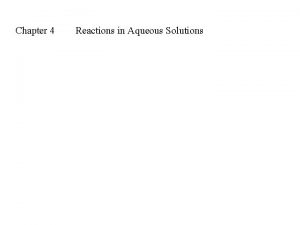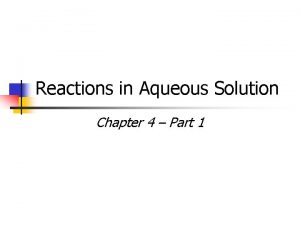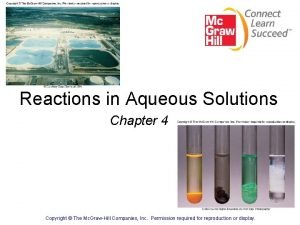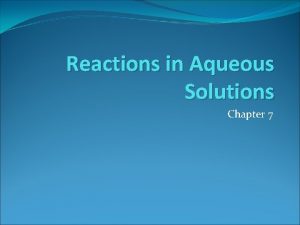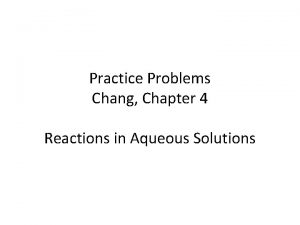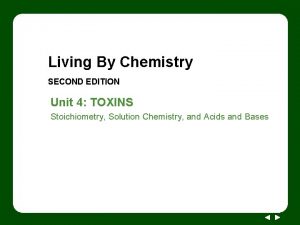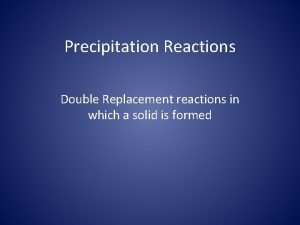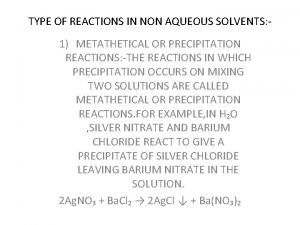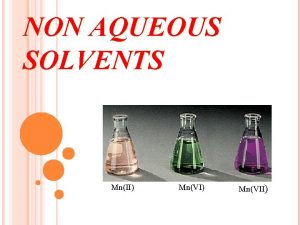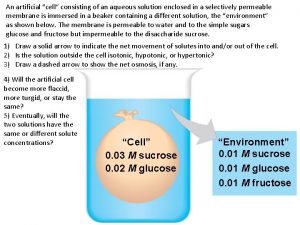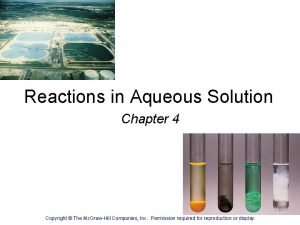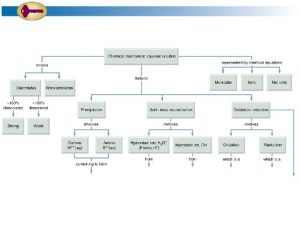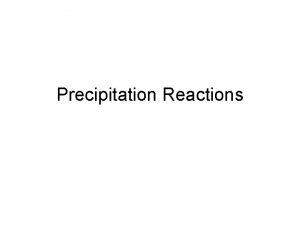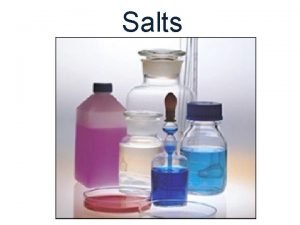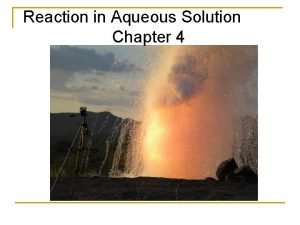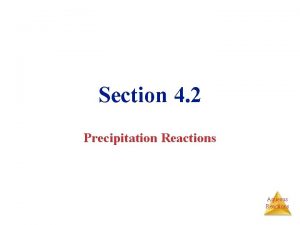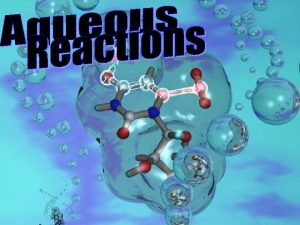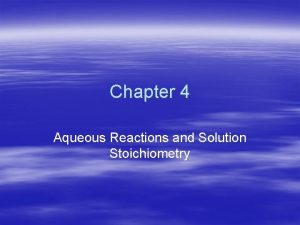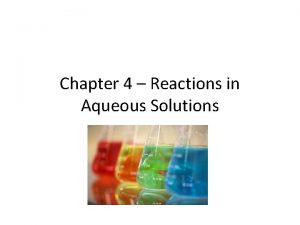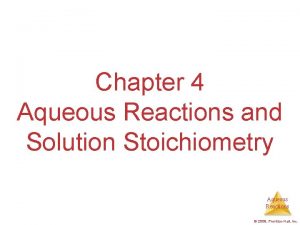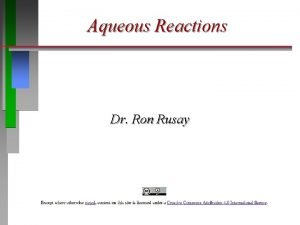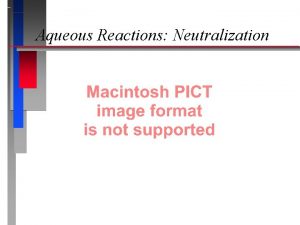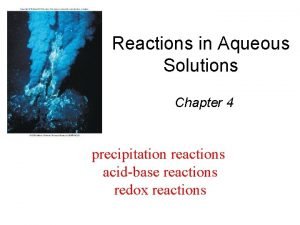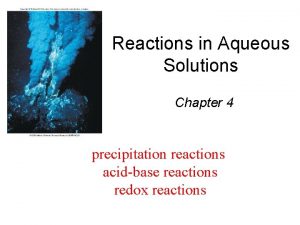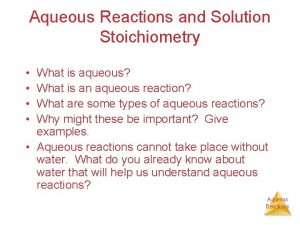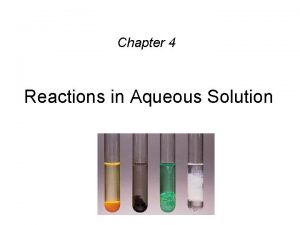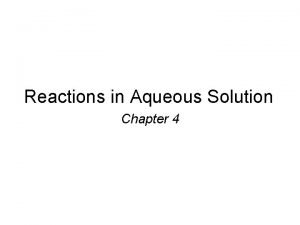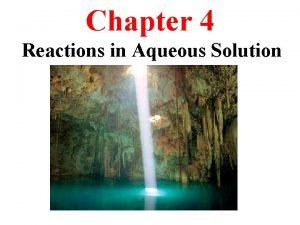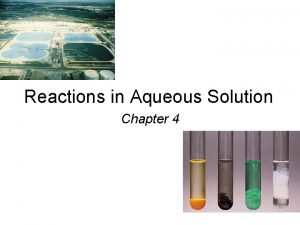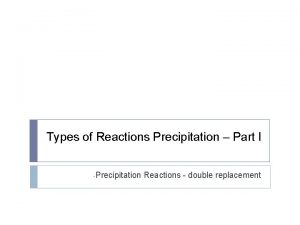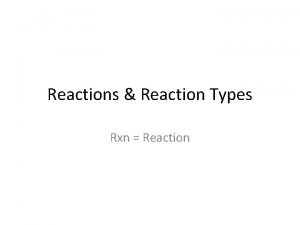Reaction in Aqueous Solution Chapter 4 Precipitation reactions
























- Slides: 24

Reaction in Aqueous Solution Chapter 4

Precipitation reactions n n Form a solid---precipitate! Remember: Solubility Rules Found on page 91 figure 4. 2 Or on the web Or you saved them from last year Yep ya gotta know em

Are the following soluble or insoluble? n Ba. Cl 2 q n n n insoluble Cr 2(CO 3)3 q n soluble Mg(OH)2 q n insoluble n K 3 PO 4 q soluble n All Chloride are soluble except Ag+Hg 2+Pb 2+ All hydroxides are insoluble except Ca 2+ Sr 2+ Ba 2+ All carbonates are insoluble except group I and NH 4+ All group I elements are soluble!

Net ionic equations Ba(NO 3)2 + Na 2 CO 3

Ba. Cl 2 + Na. OH All aqueous—no precipitate—no rxn!!!!!!!!!!!!!!!!

When sodium hydroxide and copper (II) sulfate react a with precipitate is formed. What volume of 0. 216 M Na. OH solution is required to produce 4. 328 g of precipitate? Net ionic equation?

= 0. 411 L Na. OH

Acid-base reactions n Acids q q Produce H+ in water Strong acids n n n n Completely dissociate in water HCl HBr HI H 2 SO 4 HCl. O 3 HNO 3 n Bases q q Produce OH- in water Strong bases n n n Completely dissociate in water Group I metals Heavier group II metals

Strong acid-strong base neutralization

Weak acid-strong base

Strong acid-weak base

Acid –base titrations n n n Used to determine an unknown concentration of either the acid or the base The concentration of the other solution is known and so is the volume of both solutions Equivalence point q q The point at which the reaction is complete Moles of acid = moles of base

What volume of 0. 10 M Na. OH is required to completely neutralize 250. 00 m. L of 0. 30 M HCl? = 0. 75 L Na. OH

If 25. 0 m. L of 0. 500 M Na. OH is required to react with 15. 0 m. L HCl what is the molarity of HCl ?

Oxidation-reduction reactions n Redox q Oxidation-loss of electrons n q Reduction-gain of electrons n q Oxidation number decreases Oxidizing agent n q Oxidation number increases The element that undergoes reduction Reducing agent n The element that undergoes oxidation

Balancing n n Balance the atoms Break the equation into two half reaction q q n n Oxidation Reduction Balance O’s with H 20 Balance H’s with H+ Balance the charge with electrons If confused do not use the book’s method!

Balance using half reactions Oxidizing agent Reducing agent


In a basic solution n Balance all redox in acidic solution unless stated

Balance in a basic solution Oxidizing agent Reducing agent


10 OH- + + 10 OH==8 10 HH 2 O 2 O


What volume of 0. 684 M KMn. O 4 solution is required to completely react with 27. 50 m. L of 0. 250 M Fe(NO 3)2
 Types of reactions
Types of reactions Aqueous reactions and solution stoichiometry
Aqueous reactions and solution stoichiometry Chapter 4 reactions in aqueous solutions
Chapter 4 reactions in aqueous solutions Concentrated solution
Concentrated solution Chapter 4 reactions in aqueous solutions worksheet answers
Chapter 4 reactions in aqueous solutions worksheet answers Dilute solution
Dilute solution Co precipitation and post precipitation
Co precipitation and post precipitation Co precipitation and post precipitation
Co precipitation and post precipitation Reactions in aqueous solutions
Reactions in aqueous solutions Aqueous solution practice problems
Aqueous solution practice problems Lesson 90 solid evidence precipitation reactions answer key
Lesson 90 solid evidence precipitation reactions answer key How to identify a precipitate
How to identify a precipitate Double replacement precipitation
Double replacement precipitation Types of reaction in non aqueous solvents
Types of reaction in non aqueous solvents Pelarut non air adalah
Pelarut non air adalah Non aqueous solvent example
Non aqueous solvent example An artificial cell consisting of an aqueous solution
An artificial cell consisting of an aqueous solution Titrate
Titrate The monophasic liquid dosage form is which type of solution
The monophasic liquid dosage form is which type of solution Assume that an aqueous solution of a cation
Assume that an aqueous solution of a cation How to identify a precipitation reaction
How to identify a precipitation reaction Fractional precipitation answer key
Fractional precipitation answer key Application of precipitation reaction
Application of precipitation reaction Single replacement reaction examples
Single replacement reaction examples Precipitation reaction
Precipitation reaction


